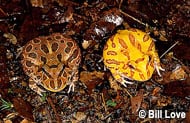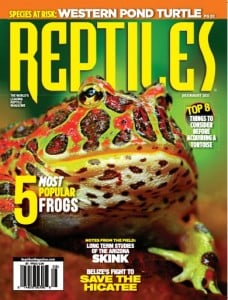Chacoan Horned Frog
Chacoan horned frogs are native to the Gran Chaco region of Argentina.
Because they have a sedentary lifestyle, Chacoan horned frogs do very well in smaller-sized enclosures. An adult C. cranwelli will thrive in a ten-gallon aquarium. Because of their propensity to feed on anything that moves, it is best to house Chacoan horned frogs separately. Newly metamorphosed specimens can be housed in plastic or glass gallon jars. White paper towels, sphagnum moss, coco coir and non-aromatic mulch all make suitable substrates. These animals can also be maintained with no substrate, just a shallow level of dechlorinated water. Because of their tremendous appetites, horned frogs produce large amounts of waste. To prevent bacterial disease (e.g. “red-leg”), keep the enclosure clean change the water or substrate as needed to keep the enclosure fresh. This usually means changing the substrate or water at least once weekly.
The Chacoan horned frog feeds on a wide variety of food items in captivity including: crickets, mealworms, cockroaches, goldfish, pink mice and even other frogs, including other C. cranwelli. Feeding these animals is accomplished best by housing them in separate enclosures. This ensures that they do not feed on each other. Crickets make a very good staple diet. Younger frogs need to be fed several times weekly; adult frogs will survive on one meal per week. As with any animal, obesity can become an issue. Crickets should be gut-loaded with fresh vegetables and a commercial cricket diet prior to offering them to the frog. It is important to dust the food item with a vitamin/mineral supplement, especially in young frogs that are growing rapidly. A supplement should be used at every other feeding for adults and at every feeding in juveniles.

